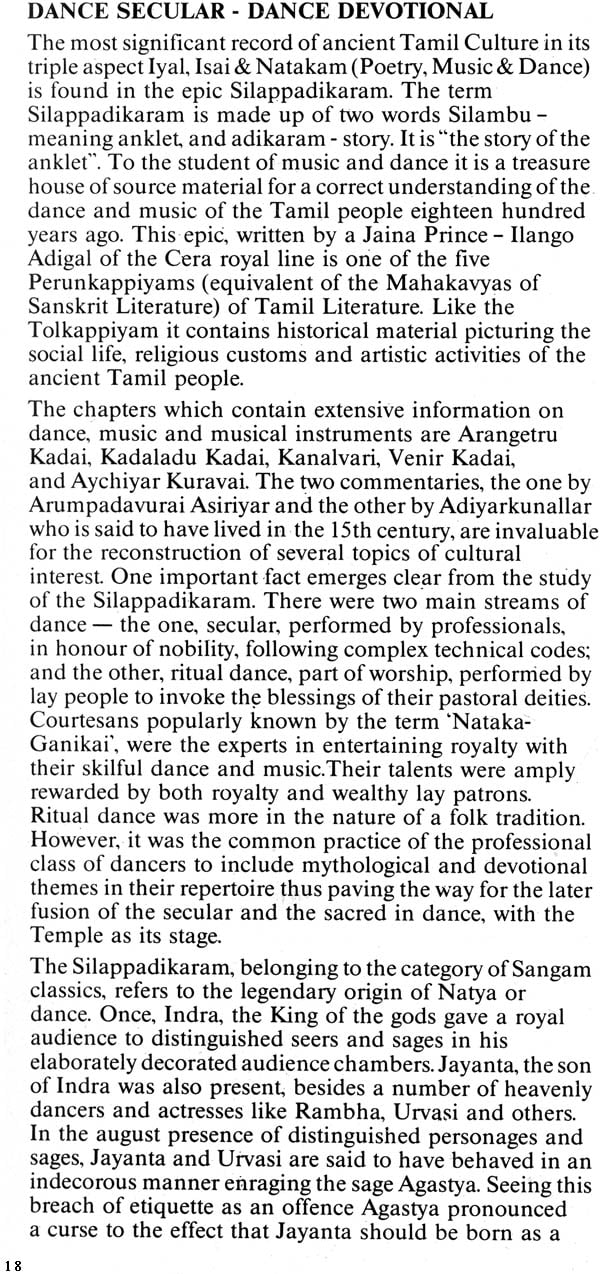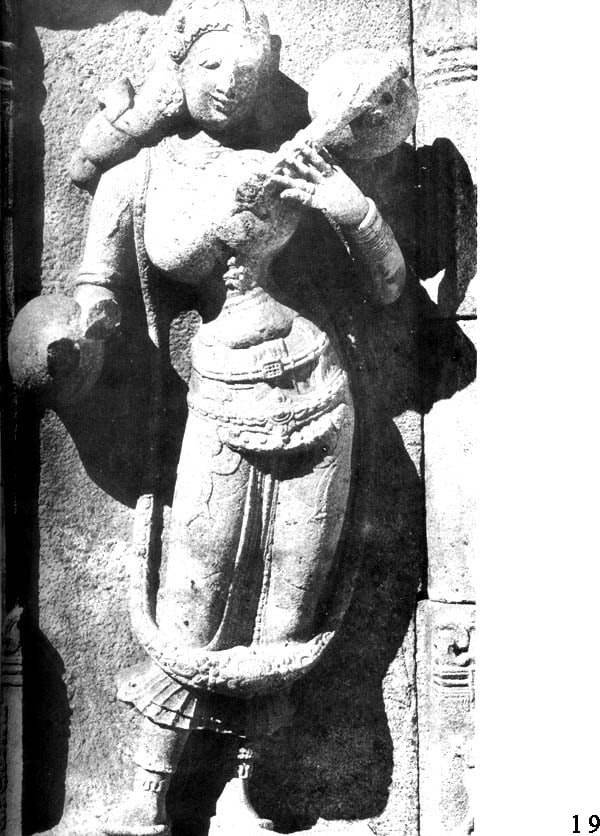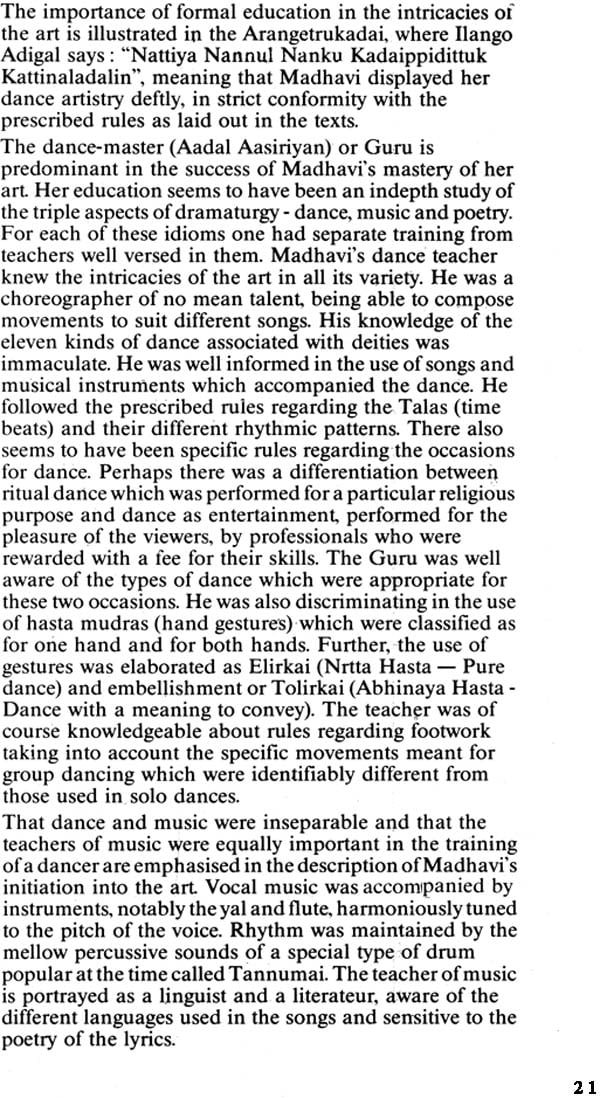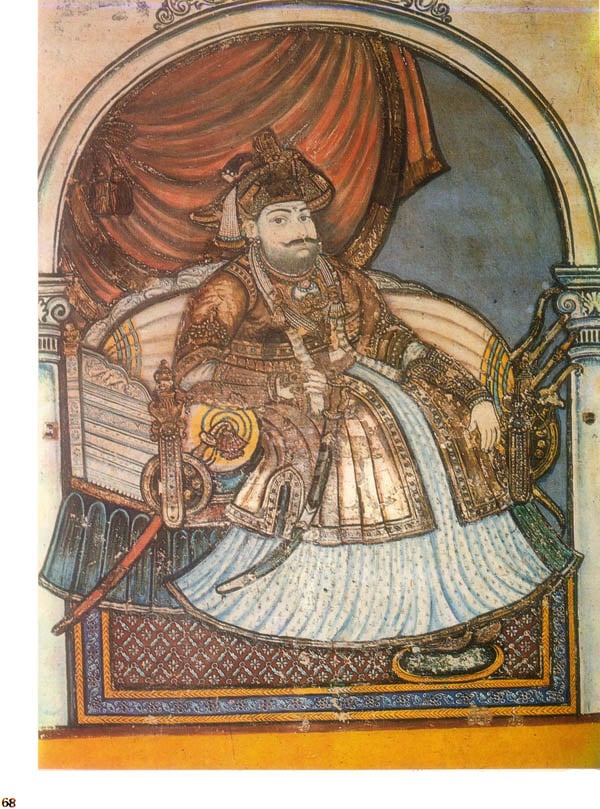
Bharatanatyam (The Tamil Heritage)
Book Specification
| Item Code: | NAL092 |
| Author: | Lakshmi Viswanathan |
| Publisher: | THE KARNATIC MUSIC BOOK CENTRE |
| Language: | English |
| Edition: | 1991 |
| Pages: | 104 (Throughout B/W and Color Illustrations) |
| Cover: | Paperback |
| Other Details | 11 inch X 8.5 inch |
| Weight | 340 gm |
Book Description
Artistic Director of the first Mamallapuram Dance Festival, Lakshmi Viswanathan Vice President of Abhai, is a dynamic personality in the cultural milieu of India. Often described as a “dancer’s dancer” and a “poetic dancer”, her career spans over two decades of performing in India and twenty five countries around the world. Acknowledge as a creative artiste who never dilutes classicism, Lakshmi represents the essence of the Tanjore tradition of Bharatanatyam which is noted for its grace in executing technique, and lyricism in expressing Abhinaya. Belonging to a family of artistes Lakshmi’s involvement in and knowledge of music is an asset to her choreography. Imagination and Sensitivity are the core of her creations as seen in the recently premiered feature “Nandanar Charitram”. Encouraged by the award “Nritya Chudamani”, Lakshmi Viswanathan widened the scope of her interest in Dance by convening the Natya Kala Conference for two years Research in the Devadasi traditions of temple dance with a fellowship, inspired her to publish a book “Bharatanatyam the Tamil Heritage”, which has been recognised as the only work which traces the roots of dance in South India from the Socio-cultural view point from the Sangam era to modern times.
Another milestone in Lakshmi’s journey of artistic creativity is a film titled “The Poetry of Dance”. Scripted, choreographed and directed by Lakshmi, this film has been acclaimed as a unique introduction to dance, aesthetically conceived and beautifully picturised in exotic locations in South India.
Lakshmi’s workshops in Europe and USA have been a major source for understanding the concept of Indian dance by people of a different culture. Invited by Universities in the USA to be an artiste in residence, Lakshmi works with dance, theatre and music students, giving them a chance to get a hands on experience of our rich techniques in movement and mime.
Lakshmi Viswanathan has now launched herself as an impresario, directing the Mamallapuram Dance Festival, which will be the first in a series of special cultural events in new venues.
There are always been a magic in Bharatanatyam, but in such variety and in so many places at different times, that it is hard to know where to start talking about it. By a fortuitous circumstance I began researching into the Devadasi tradition of Dance in the temples of Tamil Nadu, with a fellowship from the Govt. of India. I realised I was beginning to open doors for further research. A search began within myself to find expression for what had already become a way of life with dance. I felt that there were many stream in our life which have come together to form the spirit and soul of Bharatanatyam.
I began my observing the scene from the prespective of a performer. And I went back to the causes which helped the art evolving into the modern stage presentation. This naturally led to a further study to see what produced the causes and so on.
Thus, this book is about my own understanding of our people, and the patterns of influence which moulded dance in our environment. It has been an interesting and demanding experience to attempt to put across in fairly simple language several intricate concepts and ideas. I also realise, that I have only begun what can lead to more elaborate and detailed studies.
The distinct influence of the life-style of a people, their religion and the environment they create around themselves is evident in the development of the performing arts. Nowhere is this more evident than in ancient Tamil culture. Dance & Music along with Poetry which formed a concept of totality as Muttamizh, emerged from the pastoral setting in which the Tamil people lived close to nature. The landscape they inhabited could be identified by not only the flora and fauna peculiar to the different regions, but each locale had also its peculiar mode of music, musical instruments, dances, songs and poetic genres.
Melody grew from the rustic folks' sensitivity to the sound of waves, and the rustle of wind through bamboo groves. Rhythm sprouted from the ordinary domestic task of pounding rice by the women. The dance of the peacocks at the sight of rain-clouds inspired the graceful steps of youthful and shapely maidens who clasped their hands and moved in rhythmic union to propitiate the gods. Poetry blossomed forth from the longings of lovers and the effect of nature on a people who were sensitive to beauty yearning to share the sensibilities aroused by the fragrance of flowers and the coolness of the southern breeze with their kinfolk.
These beginnings reached great heights of zestful expression when the people acknowledged the power of nature by creating pastoral deities. Impelled by royalty and nobility they vied with each other in invoking the grace of the gods. Edifices of devotion, places of worship, sprouted on the Tamil soil, with the unique characteristics in architecture and sculpture of each age signifying the coming together of artiste and craftsman, solely to express the mighty commitment of a people and their kings to the betterment of the art of living.
Temples were not mere monuments. They were the focal points of an environment in which all the arts served a special function. The goal was towards achieving a perfect and harmonious outlet for devotional energy. Finding in the temple the home which would sustain their growth, Dance and Music were free to draw on Poetry for inspiration. Years of dedication towards an ideal of perfection brought about a professionalism in the arts which was rewarded by munificent patronage. The temples and the kings who endowed them were the two great sustaining forces which made the arts flourish, unfettered by the fluctuating fortunes of polity.
A host of purely Tamil terms occuring in the early literature of the Tamil people only emphasises the distinctly indigenous origin and development of music dance and other fine arts. Words commonly found in early Tamil literature such as Isai, Kuttu, Kuravai, Talaikkol, Porunar, Val, Pan, Virali and Oviyam are just a few pointers to this fact.
The waves of cultural influences from the North were like the multiple tributaries which join the river to reach the sea. Influences, both Vedic and Aryan, bringing with them the richness of Sanskrit scholarship were absorbed, adapted and modified by an already fully developed Tamil Culture. The process was one of enrichment which started perhaps even earlier than the Sangam era, and continued right to the Nayak and Mahratta regime, making the cultural horizon of the Tamil people broader.
In Chapter XIV of the Natya Sastra Bharatha elucidates specifically on South Indian Music and Dance: "Dakshinatyas taved bahugitanrtta Vadya Kaisiki Prayas Chaturamadhuralali Tangabhinayasca"
Manmohan Ghosh has translated this as follows: "Now (it is said) in that connection that the Southern (countries) favour various kind of dances, songs and instrumental music, an abundance of the graceful (Kaisiki) Style and clever and graceful gestures." An already evolved South Indian style of dance and music with its preferences in technique could only have prompted the sage to spell out this fact in his treatise.
As a performing artiste and as a researcher, born and brought up in an environment which has always reflected a complex and rich social and cultural heritage, I became both sensitive to and inquisitive about the many threads that came together from earliest times to weave the uniquely intricate pattern which defined the evolution of dance in the Tamil soil. It is, today, as impossible as it was in the Sangam era, to separate dance from the arts of music and poetry, for the roots of the concept of Muttamizh (Iyal, Isai, and Natakam - namely Poetry, Music & Dance) are planted together as one in our soil, and each is but a branch of a tradition in its totality. This concept of Muttamizh, however much it may have undergone changes in time, is the only valid artistic phenomenon which has survived through the different phases of our cultural history. Other artistic concepts and theories which at one time, linked the plastic and the performing arts have not come down to us in an unbroken tradition. The de-linking of the plastic, and performing arts may have begun with the invasion of the Tamil country by alien forces resulting in the lack of patronage for the arts. Eventuallty the Renaissance which overcame Muslim oppression and emerged with the Vijayanagar Empire in the South gave fresh impetus to creativity in the arts. Some threads were lost, others were picked up, and once again a pattern of patronage emerged under successive Nayak rulers who were themselves poets, scholars and composers.
The spirit of the Renaissance continued through the Mahratta period, during which colonisation by the Europeans could have played an indirect role in the simplification of dance technique resulting in dancers, mostly women, adopting standards of modesty in their body language which their own protective men-folk perhaps insisted on. Still, under the Nayaks and the Mahrattas, dance and music evolved into highly sophisticated art forms priveleged by the bountiful patronage of well educated rulers. Dance assimilated the present day adavu technique which retained several movements and stances such as the "Ardhamandali" (araimandi) predominantly seen in all ancient sculptural illustrations of the Natya Sastra. But the art had already by this time lost a considerable range of movements which obviously constituted the body language used in all dramatic performances envisaged as a more total concept known as "Natakam" in ancient Tamil Nadu.
However, this book does not purport to have the scope for recording a history of technique. I have made a sincere attempt to trace the role of dance in the cultural history of the Tamil country, drawing attention to the heritage which links it with our music and literature. This tradition played an important role in the environment, nurtured by a people sensitive to nature and devoted to the Supreme, using all that was in their power of creativity to enhance the status of the arts to becoming a way of life. A life that was charged with pride in performance and a dedication in the pursuit of perfection. The casting of a perfect bronze to be worshipped and meditated upon, the chiselling of a posture in stone adorning the gates of a sanctum, the love portrayed in a saint's poetry and the dance which made the deepest human emotions a communicable aesthetic experience, all had a specific function in our society. This society had its natural divisions dictated by vocations inherited by successive generations. The wisdom of a Guru was passed on to a Sishya, establishing the golden links of Parampara - the tradition which was like a smooth - flowing river, enriching itself with every fresh landscape it flowed through yet maintaining its inherent character.
| Introduction | 7 |
| Dance Pastoral | 10 |
| Dance Secular, Dance Devotional | 18 |
| Dance and the Temple - Cola Period | 33 |
| Dance and the Mystic Saint Poets | 43 |
| Dance - Sculpture | 51 |
| The Dark Days Followed by Revival | 57 |
| The Golden Era at Tanjavur | 61 |
| Dance in the Agama Sastras | 81 |
| Temple Dance and Society | 86 |
| Dance Dimensions | 95 |
| A Select Bibliography | 104 |













